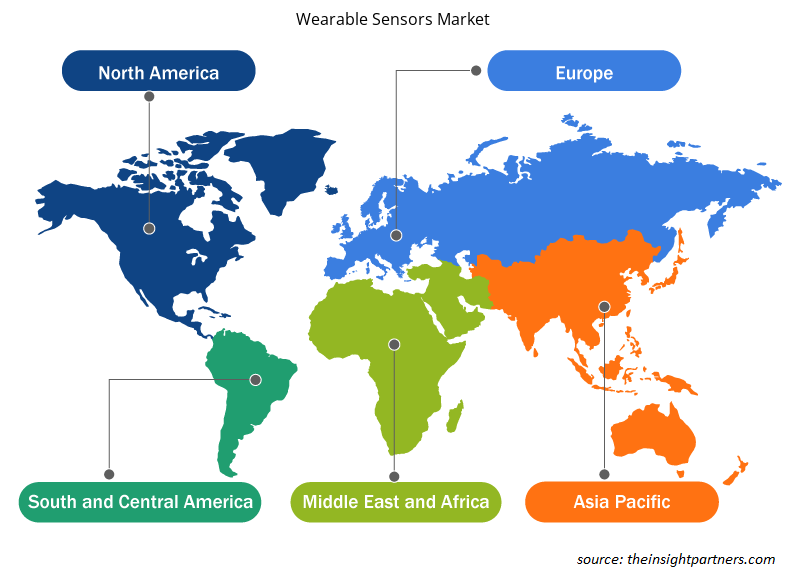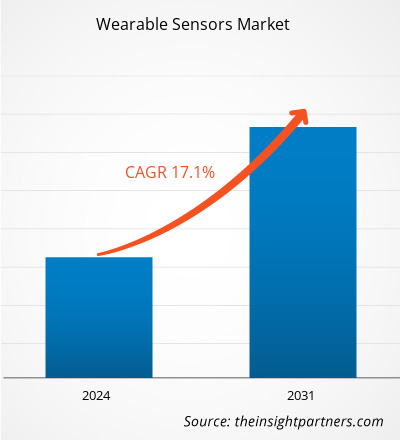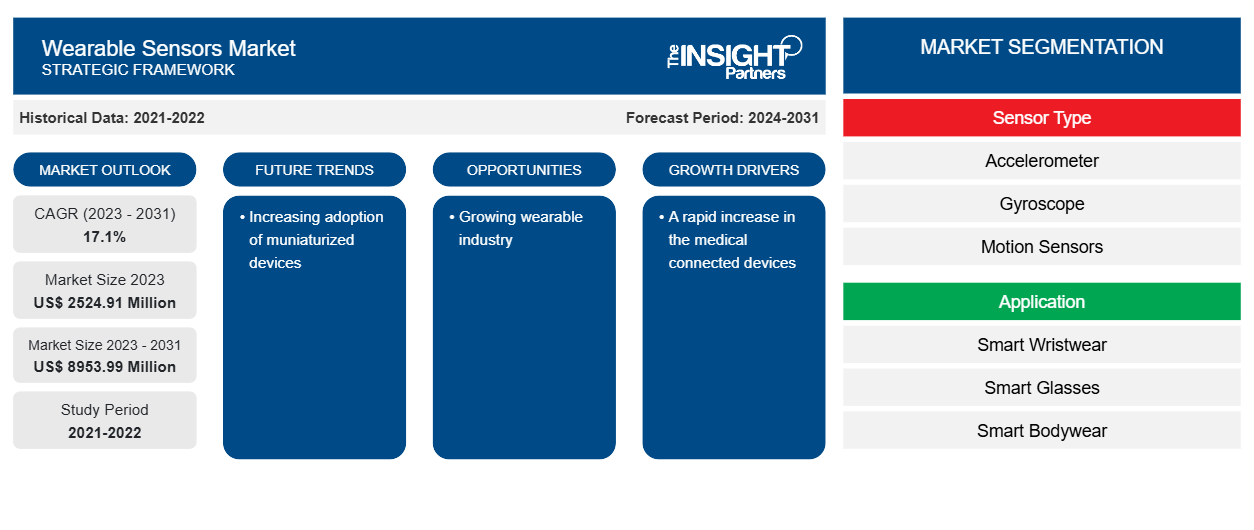웨어러블 센서 시장 규모는 2023년 25억 2,491만 달러에서 2031년 8,953.99만 달러로 성장할 것으로 예상됩니다. 이 시장은 2023~2031년 동안 17.1%의 CAGR을 기록할 것으로 예상됩니다. 소형화된 장치의 채택 증가는 시장의 주요 추세로 남을 가능성이 높습니다.
웨어러블 센서 시장 분석
연결된 기기와 스마트폰의 사용이 급증하고 성능이 개발된 저전력, 가볍고 작은 센서에 대한 수요가 증가하면서 소형화 추세가 확립되었습니다. 마이크로 제조 및 나노 기술 기술의 발전으로 소형화 프로세스가 더욱 발전하여 스마트 패브릭이 등장하고 스마트 센서가 비용 효율적으로 만들어졌습니다. 앞으로 Abbott Laboratories는 2022년 1월에 포도당 모니터링 시스템 인 Libre 3 시스템을 시연했습니다 . 따라서 웨어러블 기기에 대한 수요가 증가하면서 글로벌 웨어러블 센서 시장이 성장하고 있습니다.
웨어러블 센서 시장 개요
웨어러블 센서는 개인 건강 관리를 목적으로 생물학적 신호를 수집하기 위해 인간의 피부나 옷에 직접 부착되는 센서입니다 . MNP의 유연한 박막은 건강 신호로서 온도 및 압력 제어를 위한 적절한 기판에 증착됩니다. 사물 인터넷(IoT) 기술이 도입되면서 모든 종류의 사물이 인터넷에 연결되고 있습니다. 이러한 추세의 일환으로 웨어러블 기기에서 데이터를 수집하고 인공 지능(AI)을 사용하여 이 데이터를 분석하는 메커니즘을 만드는 데 진전이 이루어지고 있습니다. 안경, 손목 시계, 손목 밴드와 같은 웨어러블 기기는 이미 출시되어 있습니다. 그럼에도 불구하고 최근 개발된 제품에는 셔츠와 같이 매일 착용할 수 있는 품목과 박막과 엘라스토머를 사용하여 만든 고감도, 다기능, 경량의 유연한 장치가 포함됩니다.
귀하의 요구 사항에 맞게 이 보고서를 사용자 정의하세요
이 보고서의 일부 또는 국가 수준 분석, Excel 데이터 팩을 포함하여 모든 보고서에 대한 사용자 정의를 무료로 받을 수 있으며 신생 기업 및 대학을 위한 훌륭한 혜택과 할인 혜택을 이용할 수 있습니다.
-
이 보고서의 주요 시장 동향을 알아보세요.이 무료 샘플에는 시장 동향부터 추정 및 예측까지 다양한 데이터 분석이 포함됩니다.
웨어러블 센서 시장 동인 및 기회
의료용 연결 기기의 급격한 증가
디지털 헬스케어는 헬스케어와 기술 간에 연결된 개념을 포함하는 광범위한 개념입니다. 연결된 의료 기기는 환자를 원격으로 모니터링해야 할 때 중요한 요소입니다. 이러한 기기는 환자와 의료 제공자를 의료 정보로 원활하게 연결하여 헬스케어 산업을 진정으로 변화시키고 있습니다. 10년 정도 동안 기술 발전은 환자와 제공자가 커뮤니케이션 격차를 줄일 수 있는 디지털 헬스케어 기기의 시작을 목격했습니다. 연결된 BP와 같은 스마트폰 앱은 산소 수치를 모니터링하고 추적하며 상당한 데이터를 생성합니다. 대부분의 연결된 기기에는 실시간 모니터링 및 고해상도 이미징과 같은 다양한 기능이 장착되어 있습니다 . 이는 환자의 건강을 개선하는 데 기여합니다. 디지털 건강 기술을 사용하면 환자는 전 세계 어느 지역에서나 치료를 받을 수 있습니다. 이러한 기기에는 웨어러블 센서가 널리 사용되어 웨어러블 센서의 시장 성장을 촉진합니다.
성장하는 웨어러블 산업
스마트 모바일 기기와 사물 인터넷(IoT)은 사용자에게 많은 이점을 제공하고 시장에서 새로운 기회를 창출하기 때문에 웨어러블의 개발을 강화했습니다. 건강한 라이프스타일을 지원하는 소비자용 웨어러블부터 환자의 생체 신호를 제어하는 데 도움이 되는 의료용 웨어러블까지 감지 구성 요소는 이러한 웨어러블 기술을 실현하여 사용자에게 생산성, 안전감, 건강 인센티브를 제공합니다. 웨어러블 산업이 계속 성장함에 따라 웨어러블의 적절한 장기적 기능을 위해 보다 컴팩트하고 정확하며 신뢰할 수 있는 감지 기술이 필요하게 되었습니다.
웨어러블 센서 시장 보고서 세분화 분석
웨어러블 센서 시장 분석에 기여한 주요 세그먼트는 센서 유형, 응용 분야 및 수직 분야입니다.
- 센서 유형에 따라 웨어러블 센서 시장은 가속도계, 자이로스코프, 모션 센서, 이미지 센서, 압력 및 힘 센서, 터치 센서, 위치 센서 등으로 구분됩니다. 맞춤형 세그먼트는 2023년에 더 큰 시장 점유율을 차지했습니다.
- 시장은 응용 프로그램별로 스마트 손목 착용 장치, 스마트 안경, 스마트 보디웨어, 스마트 신발 등으로 구분됩니다.
- 시장은 수직적으로 가전제품, 의료, 산업 및 기업용으로 구분됩니다.
지역별 웨어러블 센서 시장 점유율 분석
웨어러블 센서 시장 보고서의 지리적 범위는 주로 북미, 아시아 태평양, 유럽, 중동 및 아프리카, 남중부 아메리카의 5개 지역으로 나뉩니다.
북미는 웨어러블 센서 시장을 지배하고 있습니다. GSM 협회에 따르면, 2021년 북미의 스마트폰 보급률은 약 81%가 될 것으로 예상되었습니다. 협회는 또한 ~3억 2,900만 명이 모바일 서비스에 가입했다고 밝혔습니다. 모바일은 경제에 계속 기여하고 있으며, 모바일 서비스 기술은 2021년 북미 GDP의 4.2%를 창출했습니다. 이 높은 보급률은 광범위한 인터넷 접속, 고급 통신 인프라, 높은 생활 수준을 포함한 다양한 요인에 기인할 수 있습니다. 따라서 이 지역에서 웨어러블 센서에 대한 수요가 증가하고 있습니다.
웨어러블 센서 시장 지역 통찰력
Insight Partners의 분석가들은 예측 기간 동안 웨어러블 센서 시장에 영향을 미치는 지역적 추세와 요인을 철저히 설명했습니다. 이 섹션에서는 북미, 유럽, 아시아 태평양, 중동 및 아프리카, 남미 및 중미의 웨어러블 센서 시장 세그먼트와 지리에 대해서도 설명합니다.

- 웨어러블 센서 시장을 위한 지역별 데이터 얻기
웨어러블 센서 시장 보고서 범위
| 보고서 속성 | 세부 |
|---|---|
| 2023년 시장 규모 | 25억 2,491만 달러 |
| 2031년까지 시장 규모 | 89억 5,399만 달러 |
| 글로벌 CAGR (2023-2031) | 17.1% |
| 역사적 데이터 | 2021-2022 |
| 예측 기간 | 2024-2031 |
| 다루는 세그먼트 |
센서 유형별
|
| 포함된 지역 및 국가 |
북아메리카
|
| 시장 선도 기업 및 주요 회사 프로필 |
|
웨어러블 센서 시장 참여자 밀도: 비즈니스 역학에 미치는 영향 이해
웨어러블 센서 시장 시장은 소비자 선호도의 변화, 기술 발전, 제품의 이점에 대한 인식 증가와 같은 요인으로 인해 최종 사용자 수요가 증가함에 따라 빠르게 성장하고 있습니다. 수요가 증가함에 따라 기업은 제품을 확장하고, 소비자의 요구를 충족하기 위해 혁신하고, 새로운 트렌드를 활용하여 시장 성장을 더욱 촉진하고 있습니다.
시장 참여자 밀도는 특정 시장이나 산업 내에서 운영되는 회사나 기업의 분포를 말합니다. 주어진 시장 공간에 얼마나 많은 경쟁자(시장 참여자)가 존재하는지 그 규모나 전체 시장 가치에 비해 나타냅니다.
웨어러블 센서 시장에서 활동하는 주요 기업은 다음과 같습니다.
- 텍사스 인스트루먼트 주식회사
- NXP 반도체
- 아날로그 디바이스 주식회사
- ST마이크로일렉트로닉스
- 인피니언 테크놀로지스 AG
- 센시리온 AG
면책 조항 : 위에 나열된 회사는 어떤 특별한 순서에 따라 순위가 매겨지지 않았습니다.

- 웨어러블 센서 시장의 주요 기업 개요를 알아보세요
웨어러블 센서 시장 뉴스 및 최근 개발
웨어러블 센서 시장은 1차 및 2차 연구 이후의 정성적, 정량적 데이터를 수집하여 평가합니다. 여기에는 중요한 기업 간행물, 협회 데이터 및 데이터베이스가 포함됩니다. 웨어러블 센서 시장의 몇 가지 개발 사항은 다음과 같습니다.
- Signify는 최근 개통한 Ahmed Hamdy 2 터널에 LED 조명을 설치한다고 발표했습니다. Signify는 국제 규격에 맞는 최신 조명 시스템을 사용하여 조명을 원격으로 제어하는 동시에 최대 70%의 에너지 절감을 제공합니다. (출처: Signify, 보도자료, 2021년 10월)
- Tungsram Group은 12월에 스페인의 "Túnel de Tresponts" 조명을 설치하기로 계약을 체결했습니다. 이 프로젝트는 부다페스트에 본사를 둔 이 회사가 2020년에 스페인에서 수주한 6번째 터널 조명 계약으로, 코로나바이러스 팬데믹으로 인한 경제적 어려움을 감안할 때 상당한 성과입니다. (출처: Tungsram Group, 보도자료, 2022년 9월)
웨어러블 센서 시장 보고서 범위 및 제공물
"웨어러블 센서 시장 규모 및 예측(2021-2031)" 보고서는 아래 영역을 포괄하는 시장에 대한 자세한 분석을 제공합니다.
- 범위에 포함된 모든 주요 시장 세그먼트에 대한 글로벌, 지역 및 국가 수준의 웨어러블 센서 시장 규모 및 예측
- 착용형 센서 시장 동향 및 드라이버, 제약 및 주요 기회와 같은 시장 역학
- 자세한 PEST/포터의 5가지 힘과 SWOT 분석
- 주요 시장 동향, 글로벌 및 지역 프레임워크, 주요 업체, 규정 및 최근 시장 개발 사항을 포괄하는 웨어러블 센서 시장 분석
- 시장 집중도, 히트맵 분석, 유명 업체, 웨어러블 센서 시장의 최근 개발 사항을 다루는 산업 환경 및 경쟁 분석
- 자세한 회사 프로필
- 과거 분석(2년), 기준 연도, CAGR을 포함한 예측(7년)
- PEST 및 SWOT 분석
- 시장 규모 가치/거래량 - 글로벌, 지역, 국가
- 산업 및 경쟁 환경
- Excel 데이터세트
최근 보고서
관련 보고서
사용 후기
구매 이유
- 정보에 기반한 의사 결정
- 시장 역학 이해
- 경쟁 분석
- 고객 인사이트
- 시장 예측
- 위험 완화
- 전략 기획
- 투자 타당성 분석
- 신흥 시장 파악
- 마케팅 전략 강화
- 운영 효율성 향상
- 규제 동향에 발맞춰 대응























 무료 샘플 받기 - 웨어러블 센서 시장
무료 샘플 받기 - 웨어러블 센서 시장